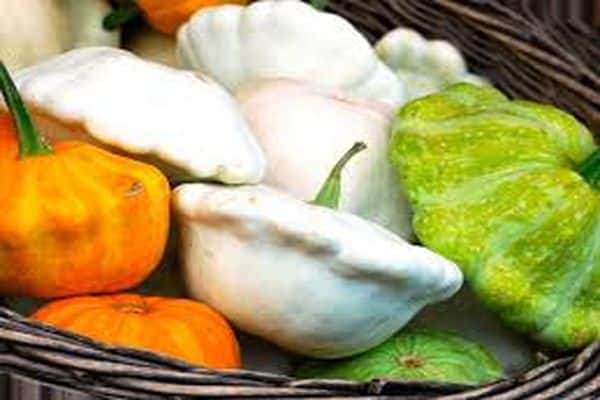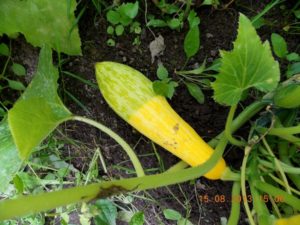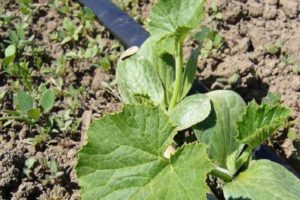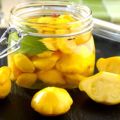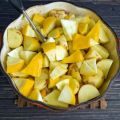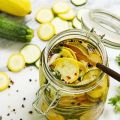Description of the varieties of squash UFO, Gosha, Disk, Solnyshko, Sunny Bunny and their yield
Patissons are favorite vegetables of the Pumpkin family. They can be eaten fried or stewed, as well as harvested for the winter. Doctors recommend including squash in their diet for people suffering from hypertension, vascular diseases or kidney problems. Previously, the squash was only white. As a result of the efforts of breeders, this vegetable is now grown in different colors, shapes and sizes. For example, UFO squash is white and orange, Gosha is distinguished by a dark green, almost black color. There are fruits with stripes or specks.
Depending on the timing of ripening, squash is divided into early, mid and late ripening varieties. All varieties of squash have useful and healing properties. One of them is the beneficial effect on human vision, due to the high content of lutein.
How to choose the right variety?
Depending on the needs, growing conditions and taste preferences, summer residents choose a suitable variety. Vegetable varieties differ not only in terms of ripening, but also in size, taste, color and shape. In order to have fresh squash all summer, and to get a harvest for canning by autumn, experienced gardeners plant several different varieties at once.
The most popular among summer residents are the following varieties:
- UFO orange squash variety. Refers to ultra-early crops. The first fruits appear 40–45 days after planting. Flat and round vegetables are orange or bright yellow. A feature of the variety is the possibility of planting in the ground without first growing seedlings. The yield of the variety is high - up to 15 kg from one bush. The use of these vegetables is universal. They are used for frying, stewing, stuffing, canning.
- UFO is white. This is a mid-season variety. Its fruits are white in color, have small teeth at the edges, weigh up to 500 g. There are almost no seeds in the fruits. Fresh fruits are suitable for consumption. Mature people lose their taste. But thanks to the dense skin, they are stored for a long time in the winter.
- Sun. Belongs to small varieties, its fruits usually do not exceed 300 g. Bright yellow color corresponds to the name. Gardeners appreciate the plant as an ornamental culture. Its bowl-shaped fruits will decorate any site. In cooking, these beautiful "cups" are used as utensils for baking dishes.
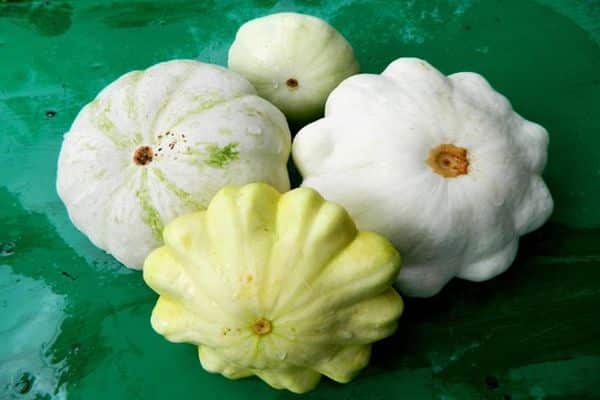
High yield, resistance to various diseases and cold resistance make the Sun one of the dacha favorites among all types of squash. It is recommended to pick its fruits unripe. As such, they will be especially tasty after cooking.
- Sun bunny. A variety prized for its high yield.Great for canning. It differs in the small size of bright yellow fruits, which have a very juicy and tasty pulp.
- Gosh. This variety stands out from the rest with an unusual color - dark green turning into black. An early ripe variety, after a month and a half, the first fruits already appear. Gosha is famous for its good taste, productivity and disease resistance. It has fruits with a maximum weight of 300 g. Small fruits are still very tasty, their flesh is tender and juicy.
- Disk. An early variety with either white or pale green fruits weighing up to 400 g. They are round, the edges are almost even, without teeth. Their dense skin allows them to be kept fresh for up to several months. The flesh is white and crispy but savory.

- Cheburashka. They say about him that he is ultra-early ripening, since the first fruits appear within 35-40 days after planting. Cheburashka bears fruit for a long time. Its smooth plate-shaped fruits reach a weight of 400 g, their color is white. The variety is appreciated for its juicy and tender pulp. Another plus of this species is resistance to cold weather, and therefore it feels great in the northern regions.
- Umbrella. Semi-bush early ripening variety. Differs in sweetish taste due to the high sugar content in fruits. Umbrella has large bell-shaped fruits, some of which reach 1.4 kg. Fruit color is white or light green. Minus - they are not stored fresh for long.
- Piglet. Also an early ripe bush. Its plus is that it is able to endure prolonged droughts. The fruits are small, the maximum grows up to 300 g, but the pulp is juicy. The variety is suitable both for fresh consumption and for pickling.
- Malachite. The description of the variety corresponds to the name. The fruits are dark green at first, but brighten when mature. The variety is practically not susceptible to diseases and drought-resistant.
There are also small varieties of squash. Mini squash are very tasty, have universal application, are well stored, easy to preserve and prepare. These varieties include Sunny Delight squash, Chartreuse, Solar Blast, Mini crumb and others.
Squash is grown in an open garden, they are unpretentious, do not require special care. All varieties are suitable for growing in Russia.
The best precursors for squash are potatoes, peas, onions, carrots, radishes, tomatoes.
How to plant and grow squash correctly?
Patissons are grown from seeds, you can plant them directly in the ground or after preparing the seedlings. Before sowing, the seeds are wrapped in gauze and soaked for a day in a solution of boric acid. After the allotted time, they are washed and dried.

To increase germination, the seeds are hardened. Having wrapped them in cheesecloth, they should be kept alternately warm and cold for three days.
For sowing, the land must be prepared in advance. The site should be well lit and warmed up by the sun. It is dug up in autumn and fertilized with humus, wood ash, manure, peat. The vegetable is planted in holes that are half a meter apart. But if the area of the garden allows, the distance between the holes can be increased to 70 cm. This will help to harvest a large crop and prevent the bushes from rotting.
The best time for sowing seeds in open ground is the last days of May or early June. If planted earlier, seeds can rot due to insufficient soil heating.

Growing seedlings allows you to grow a large harvest. Seedlings are kept at a temperature not lower than 18 and not higher than 25 degrees. Otherwise, it will be weak and the plants will not take root. Seedlings are watered moderately; waterlogging of the soil should not be allowed. If it is grown under film shelters, they should be opened and ventilated more often.
After the appearance of several strong leaves, the squash is transplanted into prepared holes.The seedlings of squash need active watering the first time after planting and during the appearance of ovaries. Watering young bushes of squash should be in the evening using warm water.
Further care consists in loosening the soil, weeding, applying mineral fertilizers. The lower leaves and fruits should be checked periodically to remove rotten ones.
Diseases of squash
Patissons are resistant to the occurrence of certain diseases. However, under certain conditions, they can be exposed to them. Most often, this vegetable gets sick with diseases such as:

- White rot - light spots appear on the leaves and stems, gradually turning into ulcers.
- Black mold - brown spots appear on the plant, they turn into holes. If you do not get rid of the problem in time, black mold gradually passes to the fruit. They dry up.
- Powdery mildew - the bush gradually becomes covered with a white bloom, stops bearing fruit and dries up.
- Anthracnose - develops in high humidity. In the absence of special treatments, it finally destroys the plant.
Harvesting and storage
Experienced gardeners recommend harvesting squash even when they are soft, not fully ripe. In this case, they are tastier. If the fruit is overripe and the skin has become hard, it is better to leave it for seeds. Cut the fruit from the bush along with the stalk.
Young and fresh squash is stored in a cool place for no more than 2 weeks. Ripe fruits are stored in the basement along with other vegetables.
Squash are recommended by doctors as a therapeutic and dietary food. Nutritionists say that this product, prepared in any form, is fully absorbed by the human body.
